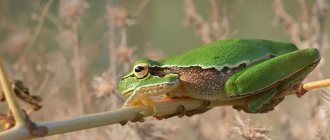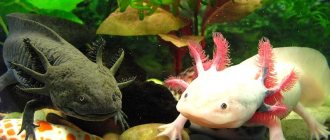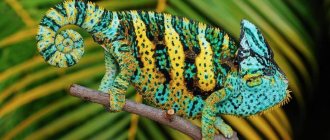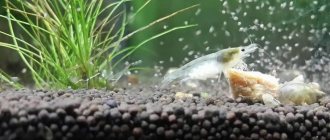Leopard geckos are a genus of lizards from the leopard gecko family. Many exotic pet lovers keep beautiful reptiles at home. They are easy to care for, but there are still some nuances of keeping leopard geckos that novice owners should familiarize themselves with.
In the article we will talk about the features of keeping and caring for a leopard gecko at home, what varieties exist, what kind of terrarium is needed, how to properly equip it, what to feed your pet, what vitamins it needs, how often does molting occur, breeding leopard geckos, the main diseases and their symptoms.
Origin of the species and description
Photo: Eublefar
Leopard geckos are small lizards from the leopard gecko family. Formally, they belong to geckos and are their suborder. Geckos have a fleshy, dense body, a large tail and a short, flattened head. The progenitor of all geckos and leopard geckos is the lizard Ardeosaurus brevipes (Ardeosaurus). Its remains are found in fossils from the Jurassic period, and its constitution resembles an almost unchanged gecko. The body of Ardeosaurus was approximately 20 cm long, with a flattened head and large eyes. It was probably a nocturnal predator, and its jaws were specialized for feeding on insects and spiders.
Interesting fact: Leopard geckos were discovered in 1827, and got their name from the combination of the words “eu” and “blephar”, which means “true eyelid” - this is due to the fact that leopard geckos have a movable eyelid, which many lizards do not have.
In general, the modern order of geckos includes the following families of lizards:
- geckos;
- carpodactylids, living exclusively in Australia;
- diplodactylidae, leading a predominantly aquatic lifestyle;
- leopard geckos;
- Philodactylidae are lizards with a unique chromosome rearrangement. They live mainly in hot countries;
- Spaerodaclitidae are the smallest representatives of the order;
- Scalepods are unique representatives that resemble snakes in appearance because they do not have legs. They are still classified as lizards, since they have the structure and lifestyle of the gecko order.
Geckoformes are a very large order, which includes more than a thousand species and about a hundred genera. The identification of individual species of lizards is controversial, since many of them differ from each other only at the molecular level.
Heating
When keeping a leopard gecko, maintaining the correct temperature is the basis. Like any reptile, this gecko can only maintain and regulate its body temperature using external heat sources. For heating, you need to install a thermal mat or thermal cord on the bottom of the terrarium (or under, if a plastic container is used) so that the warm zone occupies 1/3 of the area of the terrarium bottom and warms the soil to 32-34°C. It is also important that the warm zone is not in the middle, but at the edge of the terrarium; on the side where the ventilation is at the top. This way, the house gecko will be able to independently choose a higher or lower temperature - approaching a heated area or moving away from it into a cool zone, where the temperature should be in the range of 24-26 ° C.
Appearance and features
Photo: What does a leopard gecko look like?
Leopard geckos come in different types, depending on which their color and size vary. Typically, adults are approximately 160 cm in size, excluding the tail. The tail of these lizards is their characteristic feature. It is thick, much shorter than the body and very mobile. It has a leaf-shaped form. Leopard geckos have a disproportionately large head. Unlike other lizards, it is not elongated, but flattened, similar to an arrowhead.
Video: Eublefar
The movable neck expands into a rounded body, which also tapers towards the end. The eyes of the leopard gecko are large, from light green to almost black, with a thin black pupil. Small nostrils are clearly visible on the muzzle. The mouth line is also clear, the mouth is wide, which is why the leopard gecko is called the “smiling lizard”.
The leopard gecko has a thick, bright red tongue, which it often uses to lick its face and eyes. The color of lizards is very diverse: from white, yellow, red to black. They often have some kind of pattern on the body - small brown spots (like a leopard gecko), stripes, black asymmetric spots, etc. The entire body of leopard geckos is covered with raised soft growths. Despite their thin legs, leopard geckos run well. They move by wriggling their whole body in the likeness of a snake, although they cannot reach high speeds.
Now you know where the lizard is found. Let's see what to feed the leopard gecko?
Color
In their natural habitat, leopard geckos have a “standard” color: from sandy to light yellow with dark brown or black spots scattered over the entire surface. This combination of colors gave this gecko its name - leopard or spotted. But thanks to the efforts of breeders, today you can find a wide variety of morphs - from snow-white with neat black spots, to plain orange or coal-black. You can get an idea of the morphs of these reptiles from photos of leopard geckos posted on the Internet.
Where does the leopard gecko live?
Photo: Spotted leopard gecko
There are five species in the genus of leopard geckos, which live in different geographical locations:
- The Iranian leopard gecko lives in Iran, Syria, Iraq and Turkey. He chooses an area with a lot of stones. This is one of the largest species of leopard geckos;
- Fiscus settles in dry Indian regions. Its size reaches 40 cm, and a distinct yellow stripe runs down its back;
- Hardwick's leopard gecko lives in India and Bangladesh. This is the least studied species;
- The Leopard Gecko is the most common type of leopard gecko and is also popular for home breeding. In the wild it lives in Pakistan and northern India. They are small individuals up to 25 cm long. Being a popular terrarium animal, the spotted leopard gecko has bred many morphs (lizards of other sizes and colors) that are not found in the wild;
- The Afghan leopard gecko lives exclusively in Afghanistan, and recently began to be considered as a separate subspecies. More often referred to as the Iranian leopard gecko;
- The Turkmen leopard gecko lives in southern Turkmenistan, choosing the area near the Kapet-Dag mountains.
Leopard geckos prefer rocky or sandy terrain. This depends on their color, which is an important part of the lizard's camouflage. They hide under stones or bury themselves in the sand, becoming invisible and immune to the scorching sun.
Terrarium dimensions
For an adult gecko that lives “alone,” a terrarium with dimensions of 30x30x30 cm is sufficient. It can be oriented horizontally or vertically, but one of the walls should be equipped with shelves or niches along which the leopard gecko can move - just like on mountain slopes or rocky deserts in their natural environment.
But while the reptile is small, it is not worth purchasing a terrarium “for growth”. It is difficult for gecko cubs to hunt in a large space, so it is recommended to increase the size of the terrarium upon reaching the age of six months. After all, at about six months, these lizards begin to take a keen interest in everything around them and explore all the space available to them. In addition, it is after six months that leopard geckos begin to grow especially intensively.
What does a leopard gecko eat?
Photo: Leopard gecko
In the wild, leopard geckos are active hunters - they wait in ambush for various insects or even small mammals. For a short time, lizards are even able to pursue their prey, making short, rapid jerks.
Interesting fact: Sometimes leopard geckos do not disdain cannibalism, eating small individuals of their species.
At home, leopard geckos are fed the following foods:
- crickets – banana, two-spotted, brownie;
- Turkmen cockroaches, which reproduce well and are quickly digested;
- marble cockroaches;
- larvae of Madagascar cockroaches;
- newborn mice for large species of leopard geckos;
- butterflies and moths, which can be caught in the summer away from agricultural facilities and not within the city;
- grasshoppers. But before giving the grasshopper to the leopard gecko, you need to tear off its head, since the grasshopper can grab the lizard with its jaws and damage the pet;
- mealworm.
Before feeding, leopard geckos are given plant food so that the insect meat is better digested. It is best to give specialized supplements in the form of vitamins, dry herbs and calcium. Leopard geckos ignore berries, fruits and vegetables. It is best to feed your leopard gecko with tweezers, bringing the food directly to its face. Otherwise, during the hunt, the leopard gecko may eat earth or pebbles, and the cockroach or cricket will successfully escape from the terrarium. Feeding occurs no more than 2-3 times a week, but you need to feed at least five crickets.
Leopard geckos eat only live food, and if, for example, a grasshopper was killed, then it is important that it is fresh. Leopard geckos also need a lot of fresh water - it needs to be changed every day, creating a small flat bath in the terrarium.
How often does shedding occur?
Baby leopard geckos shed every two weeks, and adults no more than once every 1-2 months, and this process often depends on external conditions.
Molting can be determined by characteristic signs: the lizard’s skin becomes lighter, peeling and cracks appear. The leopard gecko can eat the shed skin, and this is not dangerous to its health and life.
During the molting period, it is recommended to install a damp chamber or substrate in the terrarium to moisturize the skin, which promotes its rapid renewal.
Features of character and lifestyle
Photo: Leopard gecko lizard
Leopard geckos are friendly lizards that are nocturnal. In the wild, during the daytime they hide in dug shelters, under stones and other objects. At night, they go out into the open, where they disguise themselves as their surroundings and wait for prey. Leopard geckos have become popular pets due to their personalities. They are not at all aggressive towards humans, they will never bite and will not be afraid (if, of course, you handle the lizard correctly). They are ideal for keeping in homes where there are other friendly animals or children.
In the wild, leopard geckos are solitary, but in terrariums you can keep them in pairs. The main thing is not to place several males in the terrarium, since they will constantly divide the territory, fight and may even injure each other. In the wild, males behave in a similar way: they protect the territory from attacks by other males. Each male’s territory is inhabited by a certain number of females, but they can move freely through different territories. One male and several females get along well in a terrarium.
As shelters, you should add bark, stones, and fixed pieces of trees to the terrarium, where the lizard can hide during the day. But they quickly adapt to a different way of life, especially if the leopard gecko was born in captivity. Then they willingly contact people during the day, feed in the morning, and sleep at night.
Keeping a lizard at home
In order for this exotic pet to live well next to a person, you need to take the arrangement of its home seriously.
Terrariums
They can be quite small for one individual, for example, 35x35x35 cm, and should be much longer for two or three lizards, for example, 35x35x65 cm. They can be positioned both horizontally and vertically, but in the latter case it is necessary to provide shelves, ledges and other pet climbing elements.
If the Eublefar is purchased by a baby, then at first he needs a small volume; in a large container he will become confused and feel uncomfortable, and will not be able to fully hunt. But upon reaching six months, it is necessary to transfer the pet to larger premises; at this age, he develops a desire to travel and explore new spaces. In addition, this stimulates the rapid growth of the individual.
Temperature
The leopard gecko is a cold-blooded lizard, but in order for the food in its body to be digested well, it needs warmth. The best way out is to provide heating for the lower parts of the home, using thermal coatings (thermal mats) or cords. These items are sold at pet stores.
If you were unable to buy these devices, you can place a shoe dryer under the terrarium or bury it in the bottom filler. The maximum temperature here should not exceed +32 ºC; it can be controlled by the height of the soil. To do this, use a special soil thermometer. It is enough to heat one corner of the tank, which occupies a third or a quarter of the entire space.
At room temperature +20…+23 ºC it is better to turn off forced heating at night. This gradient is familiar to lizards and only helps strengthen the immune system.
Moreover, up to three months of life, heating should work constantly, and for adult pets it can be turned on several times a day to digest food.
Arrangement of houses
A terrarium pet should have several shelter houses in different parts of the tank: in a heated one - for digesting food, in a cool one - for sleeping and resting. In addition, you need a humid chamber, where the Eublefar will shed.
The molting room must be set up in a heated place, otherwise the pet may be plunged into suspended animation.
Houses are made from various natural and decorative materials; halves of coconuts with cut out holes are very good for this.
Terrarium bottom filler
Pet salons sell special terrarium coverings that are very convenient to use and easy to clean. You can use regular mats, but not those with rubber parts.
Soil is laid on them - in the form of large stones and pebbles. The main thing is not to use rounded shapes, which are common on the banks of rivers and seas. The steppe and semi-desert inhabitants of Eublephara are not adapted to walking on slippery surfaces; their fingers must cling to rough surfaces. In addition, the size of the fractions must be such that the pet cannot swallow individual elements.
Sand is not suitable under any circumstances; problems with the digestive system and breathing will immediately begin. That is, we must remember that any shallow soil is deadly for Eublefar and can lead to complete blockage of the intestines and respiratory tract.
Drinking bowls
They use flat bowls of water; fountains are not needed. Leopard geckos do not like running water, they have never seen it in their native habitat. But these pets also prefer to lick drops, so if you spray the stones daily, you don’t have to install a drinking bowl at all.
It is better to use water with a high alkalinity.
Daylight hours
These twilight animals do not need additional lighting. You can install a small (preferably mirror) incandescent lamp with a power of no more than 40 watts. It should shine only in one corner, thus simulating solar heating. At night the lamp is turned off.
An ultraviolet lamp is definitely needed; it is used to prevent rickets and is turned on for a short time, since bright light is extremely unpleasant for lizards, and even dangerous for albinos.
Providing humidity
Its optimal rate is about 50% or slightly lower. It is especially important to monitor the level in winter when the heating is on, when the air in the house is excessively dry. Then the soil should be sprayed several times a day in one corner of the terrarium. It's even better to put a wet chamber there. Moreover, some pets like it to be in a warm corner, while others prefer a cool area.
At first, you can put two coconut halves in different places, moisten the soil under them and see which Leopard Gecko chooses.
The wet zone or chamber is very important for this lizard; it is there that molting occurs, which occurs once every 2-3 months in adults, and twice a month in juveniles. If the old skin does not peel off completely, then the pet may lose hearing, vision, and fingers. Therefore, it is necessary to carefully inspect it every day. However, if all the parameters in the terrarium are maintained correctly, then this process can occur unnoticed by the owner, since the Leopard Gecko eats the shed skin without a trace.
Molting begins with peeling and whitening of individual parts of the body and ideally the skin peels off the lizard’s body in one stocking. If it tears and does not come off, then you need to help the pet - hold it under running warm water and carefully remove the remaining coating with a cotton swab.
Fresh air
Ventilation in the terrarium is necessary. It occurs due to the convection of warm air and the installation of two holes in the lid or top of the tank.
Social structure and reproduction
Photo: Leopard gecko
Due to the fact that leopard geckos live in warm regions, they do not have a fixed mating season. The male in his territory randomly pesters females, regardless of whether they are sexually mature. If the female is not ready to mate, she drives the male away. The male is courting the female, who is ready to mate. Its tail begins to vibrate, and sometimes you can even hear the sound of vibration. Then he gently bites her on the back and neck, and if the female does not resist, the mating process begins.
The female herself prepares a place for laying, dragging wet branches, leaves, moss and pebbles there. She moistens the eggs with water, which she brings in the form of dewdrops on her skin. She lays her eggs at night or early in the morning, carefully burying them in damp sand and moss. She guards the clutch jealously, rarely leaving it to feed.
The incubation process is interesting. The fact is that the temperature determines what gender the baby will be:
- at temperatures between 29 and 32 degrees Celsius, males will appear;
- 26-28 – females appear;
- At a temperature of 28-29, both males and females appear.
Incubation can last from 40 to 70 days maximum. The small leopard gecko independently breaks through the soft shell of the egg. The cubs are completely independent, and on the third day they can already hunt.
Priming
Almost any soil can be used as a primer, namely:
- Larch bark;
- Pine bark;
- Plastic green mats;
- A rug with short and soft pile (a la artificial turf);
- Aquarium pebbles of large fraction;
- Special terrarium sand;
- and even paper napkins (for babies).
Soil that is NOT recommended to use:
- Any wet soil (coconut substrate, coconut chips, etc.);
- Large sea pebbles/large round stones;
- Sand collected from the street;
- Porous rubberized mats;
- A regular rug for the front door.
Natural enemies of the leopard gecko
Photo: Female leopard gecko
The leopard gecko is nocturnal because it is afraid of predators.
In the wild, different species of leopard geckos can be hunted by:
- foxes, wolves and dogs - especially if the leopard gecko lives near human habitats;
- cats and rats near villages and cities can also attack the lizard, including at night;
- snakes;
- owls, snake eagles and other large birds of prey. This is especially true for the Turkmen and Iranian leopard geckos, which are large in size;
- Newborn leopard geckos can become prey to other, larger leopard geckos.
No predators conduct targeted hunting of leopard geckos. Lizards lead a secretive lifestyle, and in some cases can even fend for themselves. There is no serious threat from fauna to leopard geckos.
Interesting fact: A male's courtship with a female leopard gecko does not always end in mating. Sometimes the tail vibrating and biting rituals continue for several days. If a male and a female form a permanent pair in a terrarium, then they can mate every day, but fertilization is not possible after every mating. The female carries eggs inside herself - usually from two to nine of them. The first pregnancy lasts one and a half months, all subsequent ones last two weeks.
Appeal
The pet should not be picked up until its size reaches 12 cm. The grown-up individual is allowed to be released from the terrarium and given the opportunity to move around the floor. Over time, the leopard gecko can be taught to handle. This usually takes about 5-7 days.
You should not touch the “leopard” by the tail, as there is a possibility that it will come off.
Although a new one appears in 40 days, it will not be as beautiful, and the pet may also lag behind in development.
Nutrition
The gecko is a voracious animal. The animal actively feeds every day in order to conserve energy and store a layer of fat in its tail for difficult times. The diet of reptiles is very diverse, depending on their habitat. Small predators are excellent hunters. The wide tongue is equipped with many suction cups to securely hold the victim.
The basis of nutrition for most species:
- various midges;
- insects;
- tropical cicadas;
- larvae;
- caterpillars, grasshoppers, cockroaches, beetles
The largest lizards feast on scorpions, sometimes frogs, small snakes, mice, chicks and bird eggs from nests. In caves, lizards track cockroaches gathering on bat droppings.
Natural intelligence dictates that geckos gather near glowing lamps near human habitation in anticipation of prey. Insects flying towards the light easily become prey for lizards. House geckos should have a moderate diet. Medium-sized lizards are usually fed twice a week. Large individuals are rarer.
Most animals prefer live food - flies, worms, cockroaches. Feeding insects from a pet store are mixed with ground calcium and mineral supplements for reptiles. Some species feast on bananas, oranges, and quail eggs. Lizards must have water available at all times.











